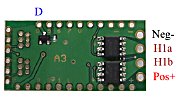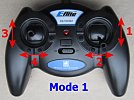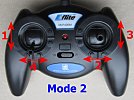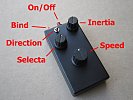

|
Rx65-22-6A1 Instructions (v611)
|

|

|

|

|

|
1. DEFAULT SETUP
|
Item |
Setting | Details |
|
Purpose: |
Rx65-22 |
Train with Tx22 transmitter |
|
Red wire positive (+) Black wire negative (-) |
Battery |
3-18v (if no BEC) Observe polarities |
|
H1 output |
Motor Ch1 |
Integrated forward/reverse ESC for brushed motors Center off |
|
F1 output 'A' (P13) |
Front Light H1 (auto) |
0v when on, disconnected when off; LED2 enabled |
|
F2 output 'B' (P14) |
Rear Light H1 (auto) |
0v when on, disconnected when off |
|
F3 output 'C' (P15) |
On/Off Ch5 |
Start disconnected, 0v (on) when channel is Low Momentary action |
|
F4 output 'D' (P5) |
On/Off Ch5 |
Start disconnected, toggle when channel is Low Latching action, P5 controls 'D' |
|
P1 |
Front Light |
Auto action, 3.5v when on, 0v off |
|
P2 |
Rear Light |
Auto action, 3.5v when on, 0v off |
|
P3 |
On/Off |
Ch2, Idle high, 0v when channel is Low, Momentary action |
|
P4 |
On/Off |
Ch4, Idle high, 0v when channel is Low, Momentary action |
|
P5 |
On/Off |
Ch5, Start high, toggle when channel is Low, Latching action (P5 controls 'D') |
|
P6 |
On/Off |
Ch3, Idle low, 3.5v when channel is Low, Momentary action |
|
P7 |
On/Off |
Ch3, Idle low, 3.5v when channel is High, Momentary action |
|
Selecta |
Enabled |
Up to 12 locos can be associated with the Selecta switch on Tx22 The selector switch position is memorised during binding. Rx 'holds' motor setting when deselected (suitable for continuous loop) Led 2-flash if loco is currently not selected |
|
L input |
Auto-detect |
Monitors single cell lipo when used with a voltage booster |
|
Arming |
Enabled |
Ch1 to center position (off) |
|
Low Voltage Cutoff |
Enabled |
Led 5-flash if triggered (LVC) |
| Cruise control | Enabled |
Outputs 'hold' last position on signal loss/Tx switched off |
| Inactivity Sleep | Enabled |
Invoked after 1hour, Switch Rx off and on to restart |
2. EXAMPLE CONNECTIONS:

|

|

|

|

|

|
'H' outputs are intended for brushed motors. This receiver has two H outputs but must be connected in parallel and used as one (H1). One is on the main receiver and the other is on the daughter board. Together it has a 6A rating. This is a maximum 'worst case' value usually measured by connecting a fully charged battery direct to a stalled motor.
'P' outputs are either 3.5v or 0v (ground). Leds need resistors to limit current to no more than 20mA. High brightness leds allow a lower current which is preferred (eg: 2-5mA). Google will reveal how to select resistor values but 220-470ohms will be safe starting values.
'F' outputs are buffered with a fet. They are 0v (ground) when on and floating (disconnected) when off. Up to 2A is possible but lower currents are much better. Current-limiting resistors are required for leds. The load is normally connected to positive and the F output provides a path to ground to switch it on. F outputs are marked with letters on the receiver (A, B, C and D). The are programmed as P outputs (P13, P14, P15 and P5). eg: F1 = A = P13.
The 'L' pad monitors a single cell lipo when used with a voltage booster. This allows the motor to be powered with a boosted voltage and benefit from the convenience of a single lipo. The receiver will cut power to the motor when the voltage falls to 3v (LVC). The L pad is not intended for use when powering a receiver direct from a single lipo.
3. BINDING
Bind once:
1. Switch Rx on and wait ~20s until led flickers fast.
2. Switch Tx on in bind mode.
3. Rx led should flash slowly; wait for it to go solid.
Change distance between Tx/Rx if binding does not work.
4. LED:
Led On = perfect reception (real-time indicator).
1 flash = Scanning (~2sec between flashes; no signal or not bound if never stops).
2 flash = Model currently not selected (Selecta).
5 flash = LVC/Brownout (voltage went too low; check battery/motor load).
5. PAPERCLIP CHANGES:
The following changes can be made by simply shorting two pads together (eg: with a paperclip):
1. Perform a 'Hard reset' (factory reset).
2. Change motor control between 'low off' and 'center off'.
3. Enable/disable LVC (eg: when using Nicads, NiHMs, LiFe cells).
4. Enable/disable Selecta.
5. Enable/disable Cruise Control/Failsafe.
'Paperclip' changes
6. PROGRAMMING:
This receiver has many other options that are described on the features page.
These are changed using a technique called 'programming': v611.